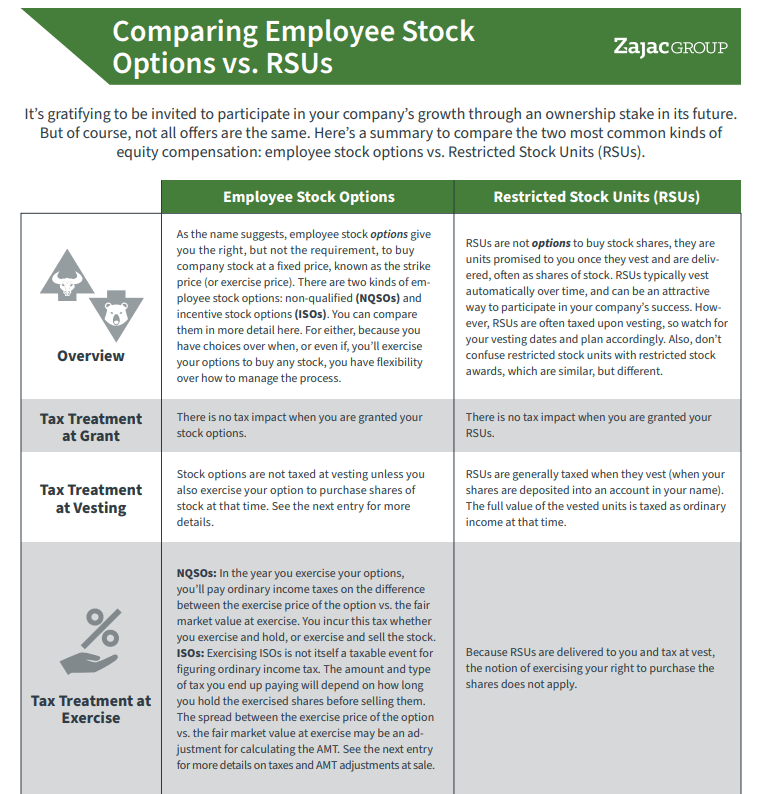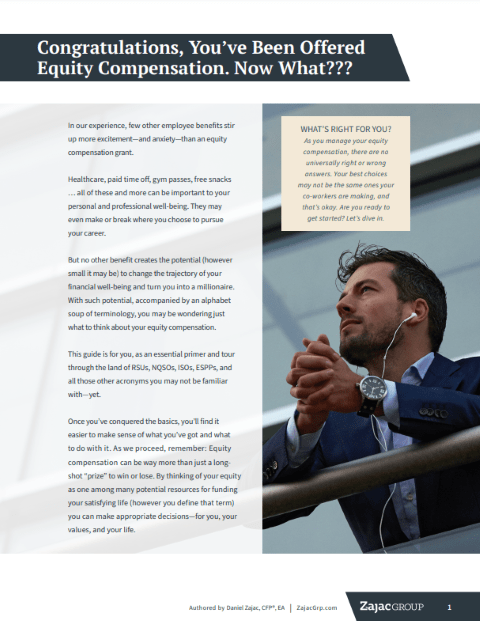If you own company stock or employee stock options, it’s possible that you have experienced market volatility and have seen firsthand how a quick change in the stock price can materially impact the value of your stock options. A rising stock price can quickly change the value of your stock options positively. Potentially to such an effect that it can create a concentrated equity position that should be evaluated.
A falling stock price, however, can negatively impact your wealth quicker than you had ever imagined.
Inherent with a single position or a concentration of employee stock options is the risk of volatility. Said another way, the risk of significant changes in the value of your stock that you assume when you own a single stock.
If you have employee stock options, you may want to consider how volatility may impact your investments. And what you may want to do during times of increased ups and downs.
Step 1 – Review and Follow Your Employee Stock Option Plan
Volatility can strike quickly and unexpectedly. General stock market swings or specific public news at your company can cause increased volatility in the value of your employee stock options. As the company stock moves up and down with the stock market or on its own, your stock options may be doing all sorts of things. Seeing the value of your stock options change so quickly may make you start second-guessing your original plan. You may start considering if you should sell all of your options now.
Rather than focusing on short-term price fluctuations of your options, volatile periods are a time to review your long-term plan. Keep in mind that you may not be in this for just a few days or weeks. Price swings are often short-term, but your focus is long-term. Allow your plan to play out or make meaningful and thoughtful adjustments as necessary.
COMPARISON GUIDE
Not All Stock Offers are the Same! Here's a helpful comparison between two of the most common employee stock options.
It may help to go back and look at how well your plan has performed so far. It’s possible that you have divested some shares based on your vesting schedule and/ or expiration schedule. Divesting shares is one way to plan, so you aren’t overweight in your company’s stock. It may also spread your tax bill across several years rather than one.
A combination of reviewing your past decision making and your short and long-term goal planning is a great way to manage fear and anxiety that arises during times of market volatility.
Step 2 – Pay Attention to Income Tax, but Don’t Let it Drive All Your Decisions
It’ not uncommon to continue holding employee stock options well after the options have vested. Rather than selling some of the shares when they are first available, the easier decision may be to continue holding stock options without a plan. In some cases, the decision to hold is a strategy focused on deferring income taxes. However, focusing too much on deferring taxes may not be the only thing you should consider when making a decision to exercise.
The longer you hold company shares because of some tax reason, the more chance your shares have of losing value due to a drop in their stock price. In fact, paying a tax bill may be a far better decision than holding a stock that decreases in price by 40% or more.
Rather than trying to plan around taxes, it may be prudent to review whether your employee stock options fit into your overall portfolio allocation and long-term financial plan. If you find that it doesn’t and that your portfolio is too heavily skewed toward company stock, it might be time to sell some shares and reallocate.
Does the company stock fit your risk tolerance profile? If you have a lower tolerance for risk and the company stock is high risk because of its industry or maybe the fact that the company isn’t yet generating any profits, it may be obvious that the company stock isn’t a match for your portfolio. Regardless of the tax hit, it may be time to sell.
Step 3 – Keep Track of Newly Granted Employee Stock Options
It’s not uncommon to receive additional employee stock option grants. Often, these grants are issued at a price equal to the current stock market price.
During periods of volatility, when the stock price is down, the grant price of newly issued stock options may be equal to that of the current market price. A lower stock price likely means a lower grant price. All else being equal, this will lead to a greater opportunity for stock option growth as compared to a stock option grant with a higher grant price (should the stock price recover).
If you retain employee stock options that have time remaining until expiration, are unvested, or you plan to keep, short term downside volatility can be viewed as an opportunity to enhance your holding with options at a lower price.
As the company stock price recovers above your cost basis, you’ll benefit from that increased holding on the newly issued stock options.
Step 4 – Be Realistic with The Stock Price
Are you holding onto your shares, thinking they may be your potential meal ticket to millions and millions of dollars? If so, you may want to check your expectations. How realistic is it to believe the stock will double in the next few years? Or triple for that matter so you can make a huge payday?
Having realistic expectations of what the stock will do just might help you avoid a terrible scenario, such as the stock quickly losing 25% or 50% of its value.
One problem is that it is hard to determine what is realistic about a stock price. One argument is that the current market price of the stock is equal to its true, current value. Anything else is simply speculative.
Other ways to consider what is realistic may be to review and evaluate earnings reports, economic output, and global market trends. Others find it important to consider their personal opinion of the company stock.
Ultimately it is important to ask yourself if you are comfortable speculating about a stock price and jeopardizing a bird in the hand? Because at the end of the day, you may be right, and you may be wrong
Just remember, the current stock price is where it’s at because that’s what everyone trading the stock believes it is worth.
Step 5 – Plan the Exercise of your Employee Stock Options
Depending on the type of stock options, ISOs (incentive stock options), or NQSOs (non-qualified stock options), the decision to exercise can vary as each type of option has different tax consequences.
NQSOs are often awarded to non-employees (i.e., consultants), while ISOs are more often awarded to employees. ISOs also have more complex tax consequences than NQSOs. Because of this, this section will reference ISOs.
It’s important to know that whatever amount your employee stock options are worth will be different from the after-tax amount. It’s the after-tax amount you’ll want to consider as it’s the amount you’ll walk away with.
Once exercised, it may be owed on the gain between the option exercise price and the fair market value at exercise price (known as the bargain element). This gain will often involve the alternative minimum tax (AMT).
Downside market volatility may mean a lower bargain element, and thus a smaller AMT hit for those exercising and holding incentive stock options. In fact, if you are bullish in the stock, a downside price movement may be a good time to exercise and hold incentive stock options, at least from a tax standpoint. Check with your accountant about the details.
Ultimately exercising stock options means owing taxes, which can be significant depending on the gain. Plan ahead so you can cover this tax bill. You may want to pay it out-of-pocket or sell some shares and pay taxes using the proceeds.
Once you have paid your taxes, you’ll have shares of company stock in your brokerage account. Do these shares fit into your portfolio allocation? Are they compromising your long-term plan in any way? Would it be better to sell some of the shares and deposit them into your retirement plan?
As the value of your shares increases, it can distort any decisions about what to do with the shares. You may decide to hold longer for even more gain, all the while your portfolio has become overweight in company stock.
Step 6 – Consider Diversification of your Employee Stock Options
Periods of stock price volatility can be a good time to review the benefits of a diversified portfolio. During volatile times, some assets will be up while others are down, and some may even be flat. A mixture of asset classes can help, so the entire portfolio isn’t down. There can be scenarios where, overall, your portfolio is down. But through diversification, some will be down less than others. But more often, it will be a mixed bag – with some assets up while others are down.
If you have a diversified portfolio in addition to your stock options, volatile periods are a time to review how each performs. Often, a diversified portfolio of assets may not have the same downside risk as does an individual stock position and may have held up considerably well.
If you find yourself without diversification, a volatile period can be a good reminder of why you may want to introduce this into the portfolio. If that is the case, an exercise and reallocation of some or all the stock options may be necessary. In fact, no matter how much your company stock is worth, how much you love the company, and how high you think it will go, diversifying is something that should at least be considered.
Step 7 – Don’t Invest Amounts You Cannot Afford To Lose
Most often than not, there’s very little reason to continue keeping a bundle of your assets tied up in one stock – whether it is your company stock or any other. In fact, concentrated equity is the opposite of diversification. More importantly, concentrated equity may mean that you are jeopardizing your financial future. And for what?
We discussed earlier the importance of having a plan and sticking it to it. Hopefully, this plan has addressed not unknowingly investing amounts that you cannot afford to lose.
When volatility strikes, it’s a good time to review the plan and remember that the money you need is invested elsewhere, and the plan still works! This review of the plan should increase your confidence, allowing you to keep on track rather than reacting emotionally.
Even more, when volatility strikes, it is nice to know that volatility is not impacting the money that you cannot afford to lose.
Dealing with Volatility on Employee Stock Options
Volatility and employee stock options go hand in hand. This is nothing new.
In fact, volatility can be good in that it may mean your employee stock options are worth considerably more than they were previously. Unfortunately, the opposite can happen, too, rapidly wiping away value. Unfortunately, it is the latter that has the ability to lead to bad outcomes.
This is why its so important to take notice of your stock options and develop a plan that considers taxes, but also your overall financial plan. A good financial plan, coupled with a continued reality check of where you are, can lead to a great outcome during the scary times of increased market volatility.












0 Comments